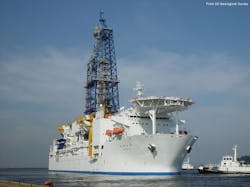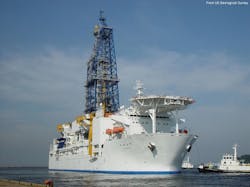USGS assists India in finding large offshore gas hydrates deposit
The US Geologic Survey has assisted India’s government in discovering large, highly concentrated natural gas hydrate deposits in the Bay of Bengal. The discovery, which is the first of its kind in the Indian Ocean, could potentially be produced, the US Department of the Interior agency said.
Gas hydrates are a naturally occurring, ice-like combination of gas and water found in the world’s oceans and polar regions. The amount of gas within the world’s gas hydrate accumulations is estimated to greatly exceed the volume of all known conventional gas resources.
This recent discovery was the result of the most comprehensive gas hydrate field venture in the world to date, made up of scientists from India, Japan, and the US, officials said. Scientists conducted ocean drilling, conventional sediment coring, pressure coring, downhole logging, and analytical activities to assess the geologic occurrence, regional context, and characteristics of gas hydrate deposits in India’s offshore area.
The research expedition was the second joint exploration for gas hydrate potential in the Indian Ocean. The first, also a partnership between scientists from India and the US, discovered gas hydrate accumulations, but in formations that were currently unlikely to be producible.
Although it is possible to produce gas from hydrates, there are significant technical challenges, depending on the location and type of formation, USGS said. Previous studies have shown that gas hydrates at high concentrations in sand reservoirs is the type of occurrence that can be most easily produced with existing technologies.
As such, the second expedition focused the exploration and discovery of highly concentrated gas hydrate occurrences in sand reservoirs. The gas hydrates found are in coarse-grained, sand-rich depositional systems in the Krishna-Godavari basin, and are made up of a sand-rich, gas-hydrate-bearing fan and channel-levee gas hydrate prospects. The next steps for research will involve production testing in these reservoirs to determine if gas production is practical and economic, the agency said.
“The results from this expedition mark a critical step forward to understanding the energy resource potential of gas hydrates,” said USGS Senior Scientist Tim Collett, who participated in the expedition.
“The discovery of what we believe to be several of the largest and most concentrated gas hydrate accumulations yet found in the world will yield the geologic and engineering data needed to better understand the geologic controls on the occurrence of gas hydrate in nature and to assess the technologies needed to safely produce gas hydrates,” Collett said.
The international team of scientists was led by India’s Oil & Natural Gas Corp. Ltd. on behalf of the Ministry of Petroleum and Natural Gas India, in cooperation with USGS, Japanese Drilling Co., and the Japan Agency for Marine-Earth Science & Technology. In addition, USGS said it is working closely with the National Institute of Advanced Industrial Science & Technology Japan on the analysis of pressure core samples collected from sand reservoirs with high gas hydrate concentrations.
The agency has a globally recognized research program studying gas hydrates in deepwater and permafrost settings worldwide. USGS researchers focus on the potential of gas hydrates as an energy resource, the impact of climate change on gas hydrates, and seafloor stability issues, officials said.
Contact Nick Snow at [email protected]
About the Author

Nick Snow
NICK SNOW covered oil and gas in Washington for more than 30 years. He worked in several capacities for The Oil Daily and was founding editor of Petroleum Finance Week before joining OGJ as its Washington correspondent in September 2005 and becoming its full-time Washington editor in October 2007. He retired from OGJ in January 2020.

